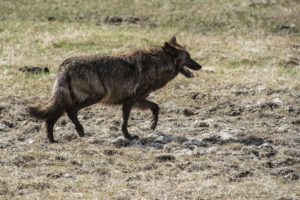Wolf hunt altered behavior in normally wild packs

A wolf trots through a field at Yellowstone National Park during the off season.
A recent spate of wolf killings just outside of Yellowstone National Park has altered fundamental aspects of the canines’ behavior, and threatened the foundations of one of the most storied wildlife research efforts in American history, according to park scientists.
Twice in recent months Yellowstone National Park senior wildlife biologist Doug Smith and his team of researchers have observed highly unusual mating behavior.
Many more wolves have been getting frisky than expected. Ordinarily in Yellowstone, only each pack’s dominant alpha male and female get the opportunity to mate. The custom is reflected in 27 years of hard data: 85% of the time, park packs produce single litters.
But this year — in the wake of at least 25 wolves being shot or trapped just beyond the park’s boundaries — Yellowstone Wolf Project personnel observed three or four females in two different Northern Range packs “tied” and breeding, Smith said. “Usually the most dominant wolf prevents other wolves from breeding,” he said. “You lose that [dominant] wolf and it opens up opportunities for other wolves.”
It appears, in other words, that with their pack hierarchies disrupted by the record-setting killings, some wolves have abandoned their selective mating customs.
“We have multiple females pregnant in at least two packs — Junction and Wapiti — that could be due to the mortality that we’ve experienced,” Smith said. “It’s broken apart the social structure, it’s messed with the hierarchy, and it’s actually produced more pups. Now this is a hypothesis, but this is what I would call an artificial stimulation of wolf reproductive capacity. By going in and killing them, you stimulate reproduction.”
Yellowstone’s Northern Range is widely regarded as the best place on the planet to watch wild wolves. For researchers it holds a unique appeal: In the Lower 48, Yellowstone is the easiest place to observe wolves in their natural state.
Since the U.S. Fish and Wildlife Service reintroduced 31 wolves to the park in 1995 and ’96, the intensive research effort has been predicated on understanding wolf ecology in the absence of human persecution. Yellowstone’s 2.2 million acres have proven a grand arena for this research. Outside of Yellowstone, about 80% of Idaho, Montana and Wyoming wolf deaths can be attributed to people, Smith said, but just 2% to 3% of wolves within the park’s boundaries succumb to humankind.
“Human-caused mortality is the story of wolves across North America,” Smith said. “One place that was not the case was Yellowstone, and we’re not anymore.”
Smith estimates it will take three to five years for Yellowstone’s wolf population to revert to a more natural condition following the 2021-22 state managed hunt — provided Montana changes the rules that allow wolf hunters to aggressively pursue the naive, human-conditioned canines without limit just outside the protected park.
All but one of Yellowstone’s nine packs lost wolves to hunters and trappers, he said.
The Junction Butte Pack — Yellowstone’s most visible wolf pack thanks to a den site near the road — was hit the hardest. Eight wolves from the once 35-animal-strong mega pack were shot or trapped over the boundary.
The Phantom Lake Pack, typically positioned between Junction Butte’s territory and the northern park boundary, used to keep the Junction Butte wolves from straying out of Yellowstone. But after six of its wolves were killed by boundary hunters, the remaining Phantom Lake wolves dispersed.
“They’re gone,” Smith said.
Other packs lost particularly influential wolves. An “unmistakable” half gray, half black 8-year-old alpha female from the 8 Mile Pack, for example, was caught in a trapper’s set outside the park boundary, Smith said.
“After she was dead,” he said, “the rest of the pack went places that they haven’t been in 10 years.”
Montana’s elimination of a stringent one-wolf hunting limit for two park-adjacent zones paved the way for the increased killings.
The new realities have created new learning opportunities for researchers, but Smith, for one, isn’t happy about it.
“The question now is … let’s see what happens,” Smith said. “But we really don’t want that, because it is not aligned with the National Park Service mission. The National Park Service mission is to protect natural processes.”



Sabrina Hanan
Thank you for posting this article. I have wondered what the indiscriminant murder of human conditioned Yellowstone wolves would do to wolf behavior. Montana did not have any concern for the long term consequences of this hunter lead experiment on wolves. Killing a human conditioned wolf by shooting it is only slightly less sadistic than trapping a human conditioned wolf. 8 Mile pack’s alpha female’s torture then death made some hunter happy. That is all that Montana cares about.